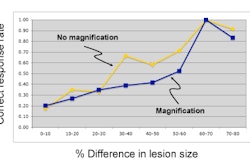A personal digital assistant (PDA) with a high-resolution display offers similar performance compared to a diagnostic workstation for reporting the presence of an acute intracranial hemorrhage, according to researchers from Ireland.
To establish how PDAs compare with radiology monitors and determine whether they are sufficient for diagnosing acute cranial bleeds, the research team compared a Dell Axim X50v PDA and a Dome C3i display (Planar Systems, Beaverton, OR), according to Philip Ryan of University College Dublin. He presented the team's research at the 2007 RSNA meeting in Chicago.
The Axim X50v features a 3.7-inch screen size, 640 x 480 pixels on its VGA display, maximum luminance of 108 cd/m², 25:1 contrast ratio, and 32 gray levels. The 3-megapixel Dome C3i display, on the other hand, provides a 20.8-inch screen size, 2048 x 1536 pixels, maximum luminance of 800 cd/m², a 900:1 contrast ratio, and 3,061 gray levels.
Thirty noncontrast cranial CT cases were acquired from a PACS, and the images were converted to uncompressed bitmap images and transferred to the PDA. Of the 30 cases, 12 had an acute intracranial hemorrhage, while 18 had no hemorrhage.
All the scans were reviewed separately in a blinded fashion by six radiologists, who were asked to grade the images using a 10-point, forced-choice Likert scale for the presence of a recent intracranial hemorrhage. After a four-week interval, the radiologists then reviewed the same scans in a DICOM file format on the dedicated radiology workstation, using the same grading system.
Based on the results from receiver operating characteristic (ROC) analysis and an analysis of variance, the researchers concluded that there was no difference in performance of the PDA and the radiology workstation. A 0.6% difference in accuracy was seen between the two displays, although the PDA was slightly less specific, Ryan said.
"False negatives were very similar for the PDA and the monitor," he said. "However, there were much more false positives generated by the PDA. This suggests that the radiologists were not fully confident in the ratings given for the PDA."
Combined observer rating greater than 5 on the PDA yielded sensitivity of 95.8% and specificity of 84.3%, compared with a sensitivity of 93.1% and specificity of 95.4% for the workstation. If the decision threshold for the PDA was lifted to 7, however, similar sensitivity (91.7%) and specificity (92.6%) to the workstation was realized, Ryan said.
In a follow-up study conducted at the university, researchers found no significant difference between using PDAs and workstations for wrist images, and a slight difference for cranial CT images (p = 0.07). As mobile devices with better specifications enter the market, continued research is required, according to Ryan.
By Erik L. Ridley
AuntMinnie.com staff writer
January 25, 2008
Related Reading
Consumer displays compare well with medical-grade displays, November 27, 2007
Radiologists slow to adopt PDAs for practice, October 12, 2005
PDAs expected to change healthcare in future, September 30, 2005
PDAs show promise for RIS/PACS portability, May 13, 2005
Skyscape, Satellife refit PDAs for African doctors, December 9, 2004
Copyright © 2008 AuntMinnie.com




















